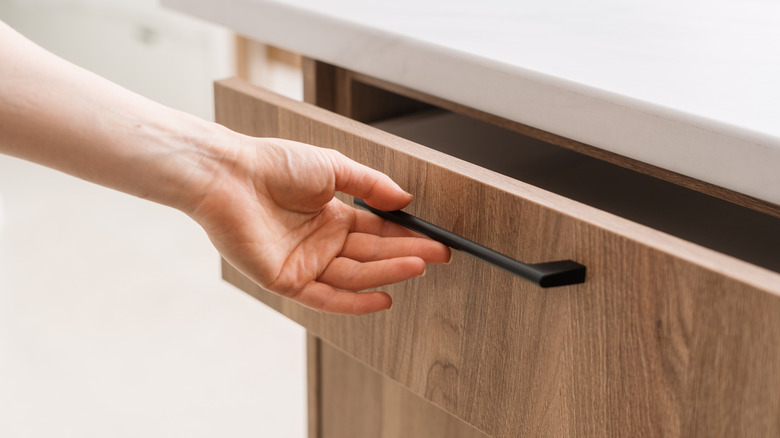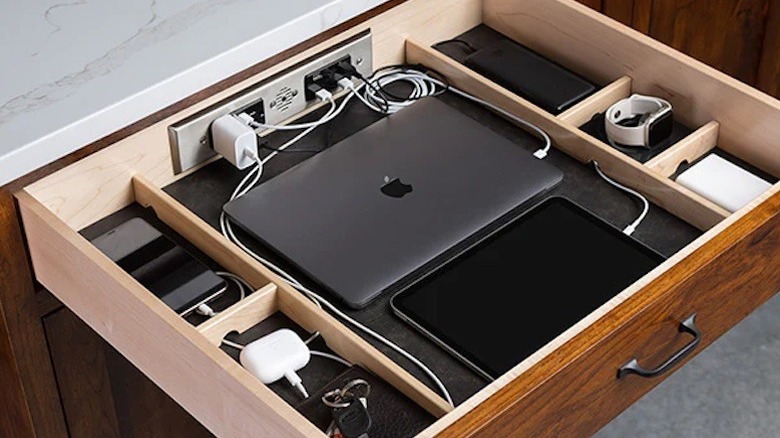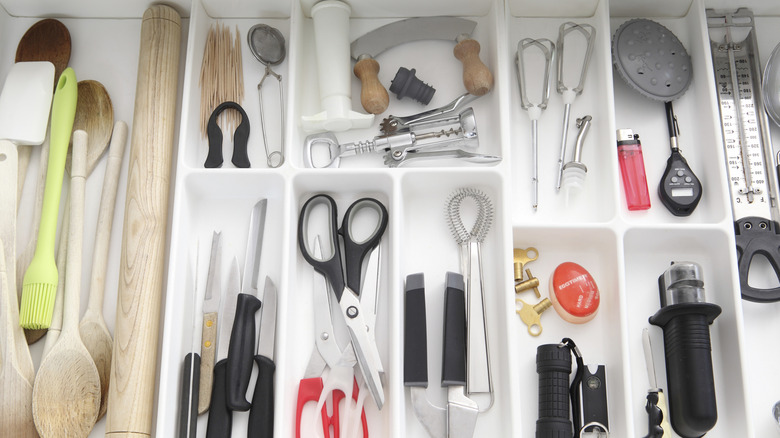Are Outlets Inside Kitchen Cabinet Drawers Practical Or More Of A Hassle?
Turning a crowded kitchen into a minimalist space is challenging, but not impossible. Minimalist details like concealed appliances and hidden outlets are easy — and trending — ways to get rid of visual clutter. Sometimes, though, it's wise to stop and ask yourself whether the trend that seems like a must-have today will stand the test of time. Hidden outlets are one of the more accessible options for homeowners looking to create a clutter-free kitchen. They can certainly enhance a streamlined aesthetic by getting your charging devices off the countertop, or allowing for a seamless look on your backsplash, but are they practical?
Specifically, you may be wondering if in-drawer outlets are worth the extra effort when compared to wall outlets. You may want to slow down to consider the pros and cons, especially if they are the only outlets in the kitchen. In-drawer outlets raise questions about safety and local building codes, which means you should take extra care before DIYing one of these drawers. And, some experts think they aren't the most practical for daily use. But slowing down to consider all sides of these sought-after kitchen features doesn't mean they aren't right for you; it just depends on how and when you want to use them.
The pros of in-drawer outlets
It's easy to see the benefits of adding a docking drawer in your kitchen. No one has ever said, "Oh, what a pretty electrical outlet!" Charging drawers give people a way to tuck one of those necessary but not-very-pretty elements you need in a kitchen out of sight. This may be a priority for people who want a sleek aesthetic or a historical look without anachronistic outlets. The benefits, however, go beyond a streamlined look. In-drawer outlets are also less likely to be exposed to water and other kitchen hazards, making them safer and cleaner than some other options.
Additionally, in-drawer outlets are out of sight even when in use. So, if you're sick of seeing ugly outlets and a tangle of wires and piles of devices on your counters, a charging drawer could be great for you, as it gives your devices a place to live whether or not they are charging. Instead of having phones, tablets, laptops, and all their respective chargers scattered around the house, you can enhance your home's organization by giving each device a dedicated space in the drawer. If you have an easily accessible wall outlet near the drawer where you want to install the charging station, this might even be a DIY-friendly job. Still, it's important to consider the cons before you start cutting into your drawers.
The cons of in-drawer outlets
The first question you may want to ask before installing an in-drawer outlet is whether you can sacrifice the storage space the drawer provides. If you have room to spare, the next question to consider is how you will use the outlets. Sticking a phone in the drawer to charge is one thing, but having to open a drawer — and leave it open — to use your blender or stand mixer may prove to be more of an annoyance in the long run. If you don't want to end up with smoothie in your drawer, you will probably still need other outlets.
Cost is also a factor. Some Docking Drawer outlet options start at $256.20, and if you hire a professional to install it, the cost will increase. While it may be tempting to stick a power strip in a drawer and call it a day, that can lead to a number of safety issues. Power strips are not meant to be used in enclosed spaces, and the drawer will likely damage the cord over time. Damaged electrical cords can cause fires, and no convenience is worth that risk. Products like those from Docking Drawer are pricy but automatically shut off when the inside temperature of the drawer gets too hot. If your budget won't allow for hidden outlets, or they just aren't practical for your needs, that doesn't mean you can't declutter your kitchen. Try this simple storage addition to clear clutter from your countertops.


